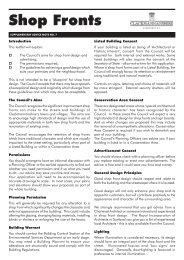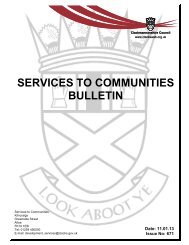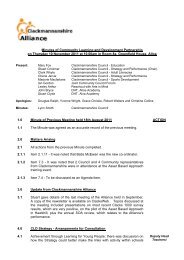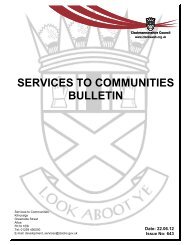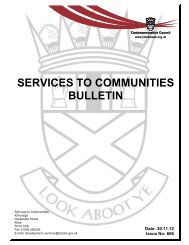Create successful ePaper yourself
Turn your PDF publications into a flip-book with our unique Google optimized e-Paper software.
The comments were analysed, communication/meetings<br />
held with all known landowners to discuss specific<br />
issues and with neighbouring local authorities (to ensure<br />
continuity of routes which go to the Council boundary),<br />
and the plan amended to produce the Final Draft Core<br />
Paths Plan.<br />
The Final Draft Core Paths Plan had a total of 178<br />
core paths with a distance of 213 km/132 miles. (For<br />
comparison, Stirling Council proposed 355 km/222 miles<br />
and Falkirk Council proposed 368 km/230 miles of core<br />
paths). One core path, at Gartmorn Dam, was on water.<br />
At the Council meeting of 5th June 2008 it was agreed<br />
that the Final Draft Core Paths Plan be progressed towards<br />
adoption by being subjected to a formal consultation.<br />
The formal consultation was in keeping with Section 18<br />
of the Land Reform (Scotland) Act 2003 which requires<br />
local authorities to publicise their Plan and any maps, and<br />
to make them available for public inspection for at least 12<br />
weeks. They must also consult the Local Access Forum for<br />
their area, persons representative of those living, working<br />
or carrying out recreational activities on the land proposed<br />
to be affected by the Plan, Scottish Natural Heritage and<br />
any other persons it deems appropriate.<br />
The formal consultation was for a 12 week period and<br />
took place between 21st July 2008 and 13th October<br />
2008. Notice of the consultations was posted on the<br />
Council Noticeboard and a copy of the Final Draft Plan<br />
(including maps and comments/objection forms) was made<br />
available for viewing at the Council’s Kilncraigs office, at<br />
public libraries, at 3 drop-in sessions (organised in Alloa,<br />
Alva and Dollar) and on the Council website.<br />
The formal consultation on the Final Draft Plan attracted<br />
6 formal objections, all of which have been resolved. 2<br />
paths were removed from the Plan, 1 was rerouted and 1<br />
extended. The other 2 formal objections were withdrawn.<br />
A number of other minor amendments have been made to<br />
the Final Draft Plan, all relating to paths which meet with<br />
core paths of neighbouring authorities. The above changes<br />
were made in keeping with the advice received from the<br />
Clackmannanshire Access Forum and the views of the<br />
local Community Council/Group and, where appropriate,<br />
land manager. The objections were posted on the Council<br />
website at http://www.clacksweb.org.uk/site/documents/<br />
countryside/finaldraftcorepathsplan/<br />
The finalised Plan, which takes account of the above<br />
formal objections and amendments, proposes 210<br />
km/131 miles of core paths and a core path on water at<br />
Gartmorn Dam. Of this, 138 km/86 miles are on land<br />
that is privately owned, 36 km/23 miles are on Council<br />
land and 35 km/22 miles are on public roads. Care has<br />
been taken to ensure that all core paths which end at<br />
the Clackmannanshire boundary connect with core paths<br />
proposed by the neighbouring authority.<br />
The list of core paths in Clackmannanshire provides<br />
information regarding the surface and nature of each path,<br />
so providing information to users on which paths are<br />
suitable for their needs.<br />
3. Links<br />
The Core Paths Plan will help the Council deliver on<br />
broader objectives.<br />
It has the potential to reduce car use by providing paths<br />
which can be used for active travel to school, work and<br />
other destinations.<br />
Core paths can also be used for a range of recreations<br />
which can generate associated health benefits.<br />
The Core Paths also have the potential to attract visitors to<br />
the area and so contribute to tourism initiatives.<br />
The Scottish Government has recently published Scottish<br />
Planning Policy 11 on Open Space and Physical Activity.<br />
This emphasises the importance of quality open spaces<br />
and sets out national planning policy on the provision<br />
and protection of open space within and on the edges<br />
of settlements, and on sports and recreation facilities in<br />
urban and rural settings.<br />
It confirms that access rights and core paths plans<br />
are material considerations in determining planning<br />
applications and highlights that local authority departments<br />
should ensure compatibility between the core paths plan<br />
and the open space strategy, local transport strategy and<br />
development plan.<br />
4. Strategic Environmental<br />
Assessment<br />
It is a Statutory requirement that a Strategic Environmental<br />
Assessment (SEA) is undertaken on the Final Draft Core<br />
Paths Plan, as per the requirements of the Environmental<br />
Assessment (Scotland) Act 2005, in order to assess the<br />
effects that the Plan could have on the environment.<br />
The Environmental Report concluded that the Plan has<br />
both positive and neutral impacts, and does not predict<br />
any significant cumulative environmental impacts. It<br />
does propose some mitigation, suggesting signage to<br />
help protect sensitive areas from disturbance and also<br />
highlighting the need for ongoing monitoring.<br />
The Environmental Report was subjected to public<br />
consultation, which ran (concurrently with the formal<br />
consultation on the Final Draft Plan) for a 12 week period<br />
from 21st July 2008 to 13th October 2008. Notice of<br />
the consultations was posted on the Council Noticeboard<br />
and a copy of Strategic Environmental Assessment<br />
Environmental Report was made available for viewing<br />
at the Council’s Kilncraigs office, at 3 drop-in sessions<br />
(organised in Alloa, Alva and Dollar) and on the Council<br />
website. 3 comments of an advisory nature were received.<br />
5. Next steps<br />
There is an expectation from the Scottish Government and<br />
the public that all the core paths will be signposted and<br />
usable by walkers, as a minimum, within 1-2 years of the<br />
Plan being adopted.<br />
6. Future review<br />
Under Section 20 of the Land Reform (Scotland) Act<br />
2003, “local authorities have a duty to review the core<br />
paths plan for their area, either when they consider<br />
appropriate or by virtue of a Ministerial direction”.<br />
Following a review, a core path can be diverted, removed<br />
or added.



